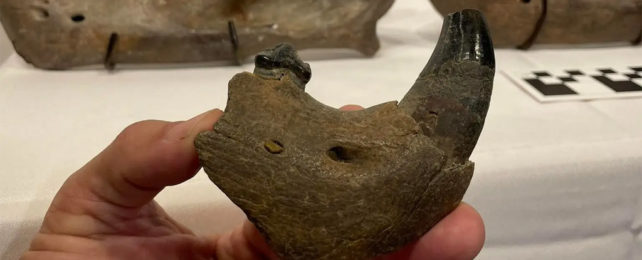At the end of October, a Mississippi resident made a rare discovery along the drought-stricken Mississippi River – a fossilized jawbone from an American lion that roamed the area roughly 11,000 years ago, according to McClatchy News.
It's only the fourth fossil of the ancient American lion found in Mississippi, according to the news outlet.
Wiley Prewitt, a local resident, stumbled on what looked like a huge black tooth in the sand and decided to take the find to a Mississippi Fossil & Artifact Symposium and Exhibition event on October 29.
"I could tell from the teeth right away that it was a fragment of a carnivore's jaw, but I dared not hope it was from an American lion," Prewitt told McClatchy News. "It certainly looked right, but I wouldn't let myself believe it."
Experts confirmed it belonged to the species Panthera atrox, more commonly known as the large American lion. Researchers believe it was the largest big cat on the continent at nearly 8 feet (2.4 meters) long, 4 feet tall, and could weigh up to 1,000 pounds, according to the National Park Service.
It's been extinct for approximately 11,000 years.
The Mississippi River is a vital transportation route, and its unusually low water levels disrupted shipping across several states in recent months.
Some locations along the river reported their lowest water levels in 10 years, the National Oceanic and Atmospheric Administration (NOAA) said in its most recent climate report, adding that barges have been unable to clear parts of the river and have run aground.
Receding water levels exposed long-submerged items
The fossil is the latest remnant of the past unearthed by the Mississippi River drought. In early October, low water levels revealed an old sunken ship along the river's banks.
Archaeologists believe the remains are from a ferry that sunk in the late 19th or early 20th century after it was damaged in a storm, The Associated Press reported.
Though this was the first time the ship has been fully exposed, small parts of the vessel emerged from low waters in the 1990s.
"At that time the vessel was completely full of mud and there was mud all around it so only the very tip tops of the sides were visible," Chip McGimsey, Louisiana's state archaeologist, told the AP when the shipwreck emerged in October.
"They had to move a lot of dirt just to get some narrow windows in to see bits and pieces," McGimsey said.
According to a growing body of research, rising global temperatures due to burning of fossil fuels enhance evaporation, making droughts more severe.
Experts previously told Insider that as human-caused climate change warms the planet and intensifies droughts, more remnants of the past may be unearthed by receding waters.
This article was originally published by Business Insider.
More from Business Insider: